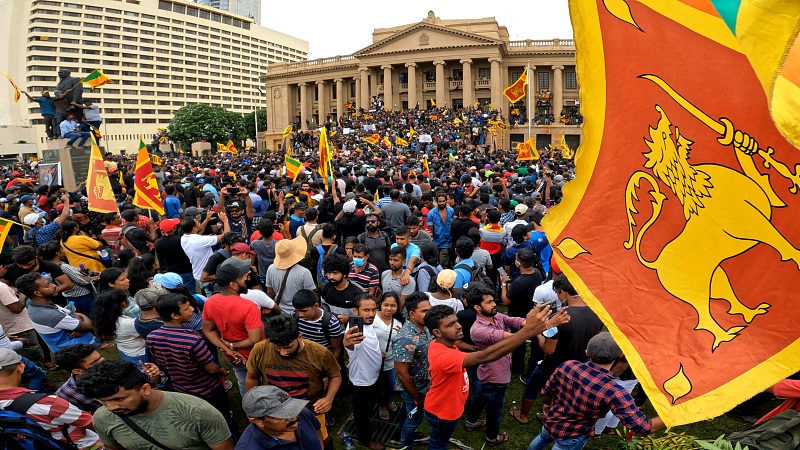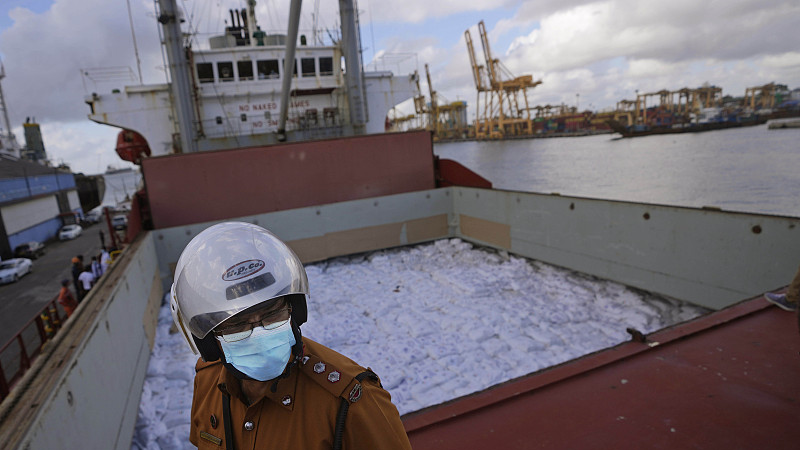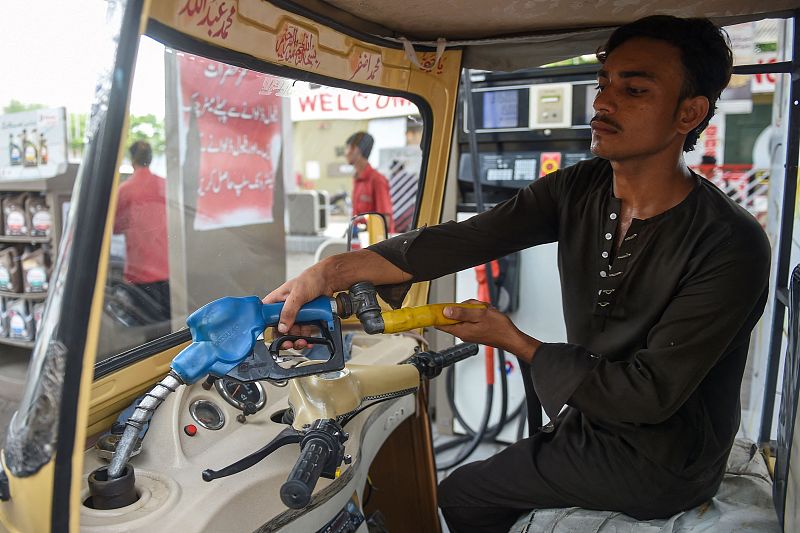
Sri Lankan anti government protesters invade the president's office during a protest at Colombo, Sri Lanka. July 9, 2022. /CFP
Sri Lankan anti government protesters invade the president's office during a protest at Colombo, Sri Lanka. July 9, 2022. /CFP
Editor's note: Abhishek G Bhaya is a senior journalist and international affairs commentator. The article reflects the author's opinions and not necessarily the views of CGTN.
The unrest in Sri Lanka went from bad to worse over the weekend after thousands of protesters stormed into the colonial-era presidential palace on Saturday and occupied it while simultaneously setting ablaze the prime minister's residence, effectively deposing the country's top leadership.
The unprecedented chain of events has pushed the embattled island nation deeper into the terrain of political and economic uncertainty, sending out shockwaves to a number of middle-income developing countries in the region and beyond who are cautiously watching the unfolding crisis.
President Gotabaya Rajapaksa was forced to flee and was reportedly holed up in a navy ship offshore. After putting up resistance for months, the 73-year-old retired military officer – who had clung to power invoking emergency laws even after deadly nationwide violence in May forced his elder brother Mahinda Rajapaksa to quit as prime minister – finally succumbed to intense public pressure and announced he will resign on Wednesday.
Prime Minister Ranil Wickremesinghe, who had replaced the elder Rajapaksa just two months ago, said he will step down too, prompting speculations over who will form the next government and pull out the country from the mess that it finds itself in.
The rapidly unfolding situation in the country of 22 million – that has had the distinction of having the second-best per capita GDP (only behind the Maldives) among the South Asian economies for decades – is at many levels worse than the typical financial crises seen in the developing world through history.
Once seen as a model for a developing economy, Sri Lankans are now left struggling to buy food, fuel, essential medicines, and other necessities for months, with most of the country facing frequent blackouts. Sri Lanka defaulted on its $51-billion debt in May, with Wickremesinghe admitting later that the economy had "collapsed."
The crisis is largely the result of the government's confounding economic mismanagement and corruption, combined with the disruption caused by the COVID-19 pandemic, which, along with the 2019 easter terrorism attacks, have wrecked the country's important tourism industry that accounts for 12 percent of national GDP.
The COVID-19 pandemic also disrupted the flow of substantial remittances from the Sri Lankan diaspora abroad, which contribute 8-10 percent to its GDP. The result is a country on the verge of bankruptcy, with little or no money left to import gasoline, milk, cooking gas, toilet paper, and medicines.
China, India, and IMF offer hope

A Sri Lankan port worker stands on a ship that carried emergency supplies granted as humanitarian aid by the Indian government to Sri Lankan people at a port in Colombo, Sri Lanka, May 22, 2022. /CFP
A Sri Lankan port worker stands on a ship that carried emergency supplies granted as humanitarian aid by the Indian government to Sri Lankan people at a port in Colombo, Sri Lanka, May 22, 2022. /CFP
Earlier, the Rajapaksa government had held off talks with the International Monetary Fund (IMF) over a rescue plan despite the precarious economic situation, but Wickremesinghe, who is also the finance minister, began negotiations with the global lender for a possible multibillion-dollar bailout.
The ongoing political unrest has clouded the outcome of those talks for now. IMF said on Sunday it was keeping an eye on developments. "We hope for a resolution of the current situation that will allow for the resumption of our dialogue on an IMF-supported program," it said.
Meanwhile, Sri Lanka's biggest neighbors and partners – China and India – are closely monitoring the situation and have provided much-needed emergency aid in recent weeks. India has extended billions of dollars in loans to help pay for vital supplies.
While the Sri Lankan society and political leadership will have to reconcile and draw up a path to political recovery, it will need support from all its regional and global partners including multilateral agencies such as the IMF to guide it on a course for economic recovery. The debt restructuring process will be tough and a long-drawn-out challenge not just for Sri Lanka but also for the rest of the world.
Warning sign for other countries
What Sri Lanka is facing today is more commonly seen in poorer or war-torn countries, but a total political and economic collapse at this scale, although rare, is not completely unknown in middle-income countries. Oil-rich Venezuela's unending political crisis that began during the presidency of Hugo Chavez in the early years of this millennium had badly destroyed its economy, resulting in the exodus of 6 million Venezuelans.
Indonesia, once touted as one of the Asian "Tiger" economies, witnessed and endured an economic depression-like crisis in the late 1990s that led to violent protests and political unrest that led to the ouster of President Suharto who had held power for 31 years. The Southeast Asian country eventually overcame the crisis and is today a member of the G20 group of the world's largest industrial economies.
It is still not clear what direction will Sri Lanka take in the coming months, but the unfolding economic and political crisis in the country is being keenly watched as a warning sign by a number of other debt-laden middle-income developing nations.

An autorickshaw driver fills his vehicle's tank at a gasoline station following a rise in petroleum prices by the government in Karachi, Pakistan, May 27, 2022. /CFP
An autorickshaw driver fills his vehicle's tank at a gasoline station following a rise in petroleum prices by the government in Karachi, Pakistan, May 27, 2022. /CFP
Many of these countries are increasingly vulnerable in the aftermath of global turbulence caused by the COVID-19 pandemic, the ongoing Russia-Ukraine conflict, and rising U.S. interest rates that are causing supply-chain disruptions, food shortages, and high inflation.
While countries far from Sri Lanka, such as Lebanon and Zambia, are already facing economic turmoil as a consequence of their swelling debts and seeking international loans to restructure their financial obligations, closer home another South Asian country, Pakistan, is staring at a crisis of a similar nature as inflation batters its economy.
Pakistan's new government, which came to power in April, said in May that it narrowly escaped a debt default, driven essentially by a soaring fuel-import bill and a wave of inflation propelled by the Russia-Ukraine conflict. The country has seen its foreign exchange reserves dwindle to cover just two months of imports and is seeking an urgent bailout from the IMF.
Pakistan removed a $600 million-a-month gasoline subsidy in June, to bring back government finances under control. It has also raised the domestic retail price of gasoline and electricity several times over the past few weeks, on par with the international oil prices.
Meanwhile, in Laos, inflation hit an annual rate of 24 percent last month and a decline in dollar reserves meant it can't import oil and other essentials to meet its domestic demand. According to World Bank estimates, by 2021 end Laos had foreign-exchange reserves of $1.3 billion, which could only cover for little over two months of imports.
As Sri Lanka fights a tough battle at home, the world, and particularly countries facing similar economic faultlines will keenly look for lessons that could address the global food, fuel, and financial crisis and help them avoid a looming disaster.
(If you want to contribute and have specific expertise, please contact us at opinions@cgtn.com. Follow @thouse_opinions on Twitter to discover the latest commentaries on CGTN Opinion section.)

